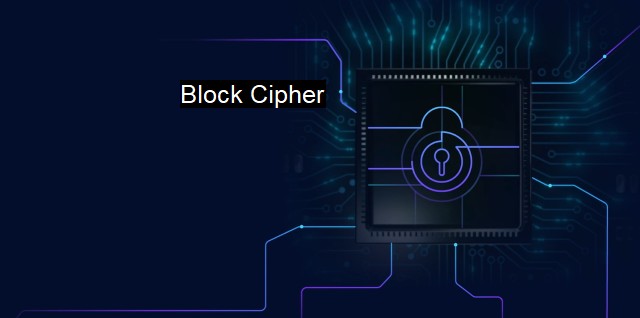What is Block Cipher?
Block Cipher: Strengthening Cybersecurity Measures through Fixed-Length Encryption Blocks and Unique Keys
Block cipher is a type of symmetric key cipher technique used broadly in Information Security for encrypting bulk data. It is defined as the method of taking plain text (input) in cryptology and transforming it into cipher text by applying cryptographic keys. The concept of symmetric cryptography signifies that the key applied for encryption is the same that is used for decryption. Therefore, the security of the block cipher remains crucially dependent on the secrecy of the key.A block cipher operates under defined lengths of bits termed as blocks. These blocks are implemented in the form of a matrix. The encryption and decryption process is based on the application of the algorithms over these blocks of data rather than on individual bits being separately encrypted.
The most common standard block size for block ciphers today is 128 bits. Simpler block ciphers were originally designed with 64-bit blocks, but they can be vulnerable to attacks if used in certain ways. Therefore, modern practice is to use a cipher with at least 128-bit blocks.
Block cipher operates through several rounds where each round involves substitution and permutation, producing a unique bit of encrypted text each time. This makes it immensely complex to reverse-engineer the data back to its original form, providing a superior level of security.
The different types of Block Ciphers can be categorized into five broad types: Data Encryption Standard (DES), Triple-DES (3DES), Advanced Encryption Standard (AES), Blowfish, and Twofish. Each one of these block cipher types operates with a distinctive algorithm and block size.
For instance, DES accepts the message in 64-bit blocks utilizing a 56-bit key. AES accepts the input as block sizes of 128 bits but offers options amongst 128, 192, or 256-bit keys. Blowfish has a block size of 64 bits and key lengths of 32 to 448 bits. Twofish uses 128-bit blocks and keys up to 256 bits long.
In designing the block cipher, some cryptographic principles must be kept in mind such as resistance to known-cryptanalytic attacks, simplicity of the algorithm, speed and efficiency in various hardware and software platforms.
One significant drawback with block cipher is that identical plaintext blocks are encrypted into identical ciphertext blocks, thus it could lead to the possibility of security threats because if recognized, an attacker can derive a pattern. Therefore, to ensure more secure encryption, techniques such as Cipher Block Chaining (CBC) or Cipher Feedback (CFB) are utilized.
In the context of cybersecurity and antiviruses, block cipher plays a pivotal role. We live in an era where data breaches occur frequently which could compromise personal data or sensitive company information. Antiviruses with their built-in encryption tools employ block cipher algorithms to provide data protection and integrity.
Not only does the block cipher safeguard your data from being tampered with or accessed by unauthorized outsiders, but it contributes to the secure transmission of your information over the internet. It could protect financial data transactions, secure confidential emails, or shelter proprietary or classified information from unencrypted exposure to potential threats.
Thus, block ciphers remain vitally significant in the realm of cybersecurity and encryption. By maintaining the confidentiality, integrity, and availability of information, block ciphers uphold the triad model of information security, standing as a formidable bulwark against unauthorized infiltration.

Block Cipher FAQs
What is a block cipher?
A block cipher is a cryptographic algorithm that operates on a fixed-size block of data to transform it into a ciphertext. It is commonly used for data encryption in cybersecurity and antivirus systems.How does a block cipher work?
A block cipher takes a fixed-sized block of plaintext as input and performs a series of mathematical operations on it to generate a block of ciphertext. The process is done repeatedly until the entire message is encrypted. The key used in the encryption is secret and is required to decrypt the ciphertext.What are the advantages of using a block cipher?
Block ciphers provide a high level of security and confidentiality as they use complex mathematical algorithms to encrypt data. They are also fast and efficient, making them ideal for use in antiviral and cybersecurity systems. Block ciphers are also highly customizable, allowing them to be tailored to specific use cases.What are the limitations of block ciphers?
The main limitation of block ciphers is that they operate on fixed-size blocks of data, which can lead to padding or truncation issues in some situations. Additionally, block ciphers may be susceptible to certain attacks, such as the birthday attack and brute-force attacks, which can compromise the security of the encrypted data. Overall, it is important to choose the right block cipher and implement it correctly to ensure maximum security.| | A | | | B | | | C | | | D | | | E | | | F | | | G | | | H | | | I | | | J | | | K | | | L | | | M | |
| | N | | | O | | | P | | | Q | | | R | | | S | | | T | | | U | | | V | | | W | | | X | | | Y | | | Z | |
| | 1 | | | 2 | | | 3 | | | 4 | | | 7 | | | 8 | | |||||||